Reign of Maria I
| Image | Name | Regency start | Regency end |
|---|---|---|---|
| Regent during the incapacitation of Queen Maria I. | |||
 | John | 16 December 1815 | 20 March 1816 Death of Queen Maria I. |
This is a list of Brazilian regents, a regent, from Latin regens, "one who reigns", is a person selected to act as head of state (ruling or not) because the ruler is a minor, not present, or debilitated. [1]
| Image | Name | Regency start | Regency end |
|---|---|---|---|
| Regent during the incapacitation of Queen Maria I. | |||
 | John | 16 December 1815 | 20 March 1816 Death of Queen Maria I. |
| Image | Name | Regency start | Regency end |
|---|---|---|---|
| Regent after the King John VI left Brazil. | |||
 | Pedro | 22 April 1821 | 12 October 1822 Accession as Emperor of Brazil. |
Regents during the minority of emperor Pedro II
The regencies took place from 1831 to 1840, between the abdication of Pedro I of Brazil until the majority of Pedro II legally declared by the Senate at the age of 14 on July 23, 1840.
| Image | Name | Regency start | Regency end | |||
|---|---|---|---|---|---|---|
| Provisional Triumviral Regency | ||||||
   | Francisco de Lima e Silva Nicolau Vergueiro José Carneiro de Campos | 7 April 1831 | 18 June 1831 | |||
| Permanent Triumviral Regency | ||||||
  | Francisco de Lima e Silva José da Costa Carvalho João Bráulio Muniz | 18 June 1831 | 12 October 1835 | |||
| Regency of Priest Feijó | ||||||
 | Diogo Antônio Feijó | 12 October 1835 | 18 September 1837 | |||
| Regency of Araújo Lima | ||||||
 | Pedro de Araújo Lima | 19 September 1837 | 23 July 1840 | |||
Women heads of state during the Empire
In addition to the regencies listed above, two other people held the Head of State of Brazil during the imperial period, Maria Leopoldina and Isabel, Princess Imperial of Brazil. D. Leopoldina who acted as regent in 1822 and had a great influence on Brazil's independence process, having been responsible for signing the decree that separated Brazil from Portugal.
D. Isabel, heir presumptive to the throne, who was Regent of Brazil in various periods (1870–1871, 1876–1877 and 1887–1888) while her father, Emperor Pedro II, performed foreign visits. During her last regency she sanctioned on 13 May 1888, the Golden Law (Imperial Law n.º 3.353), which was the law that extinguished slavery in Brazil, considered a great milestone in the history of Brazil.
| Image | Women Regents | Monarch |
|---|---|---|
 | Maria Leopoldina of Austria | Pedro I of Brazil |
 | Isabel, Princess Imperial of Brazil | Pedro II of Brazil |

DomPedro II, nicknamed the Magnanimous, was the second and last monarch of the Empire of Brazil, reigning for over 58 years. He was born in Rio de Janeiro, the seventh child of Emperor Dom Pedro I of Brazil and Empress Dona Maria Leopoldina and thus a member of the Brazilian branch of the House of Braganza. His father's abrupt abdication and departure to Europe in 1831 left the five-year-old as emperor and led to a grim and lonely childhood and adolescence, obliged to spend his time studying in preparation for rule. His experiences with court intrigues and political disputes during this period greatly affected his later character; he grew into a man with a strong sense of duty and devotion toward his country and his people, yet increasingly resentful of his role as monarch.

Dona Maria II "the Educator" or "the Good Mother", was Queen of Portugal from 1826 to 1828, and again from 1834 to 1853.

Manuel Deodoro da Fonseca was a Brazilian politician and military officer who served as the first president of Brazil. He was born in Alagoas in a military family, followed a military career, and became a national figure. Fonseca took office as provisional president after heading a military coup that deposed Emperor Pedro II and established the First Brazilian Republic in 1889, disestablishing the Empire. After his election in 1891, he stepped down the same year under great political pressure when he dissolved the National Congress. He died less than a year later.

The Most Serene House of Braganza, also known as the Brigantine dynasty, is a dynasty of emperors, kings, princes, and dukes of Portuguese origin which reigned in Europe and the Americas.

The Lei Áurea, officialy Law No. 3,353 of 13 May 1888, is the law that abolished slavery in Brazil. It was signed by Isabel, Princess Imperial of Brazil (1846–1921), an opponent of slavery, who acted as regent to emperor Pedro II, who was in Europe.

Dona Maria Leopoldina of Austria was the first Empress of Brazil as the wife of Emperor Dom Pedro I from 12 October 1822 until her death. She was also Queen of Portugal during her husband's brief reign as King Dom Pedro IV from 10 March to 2 May 1826.
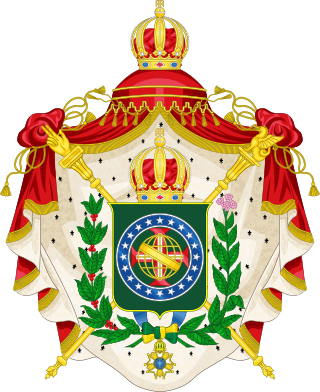
The Imperial House of Brazil is a Brazilian dynasty of Portuguese origin that ruled the Empire of Brazil from 1822 to 1889, after the proclamation of independence by Prince Pedro of Braganza who was later acclaimed as Pedro I, Constitutional Emperor and Perpetual Defender of Brazil. The members of the family are dynastic descendants of Emperor Pedro I. Claimants to headship of the post-monarchic Brazilian Imperial legacy descend from Emperor Pedro II, including the senior agnates of two branches of the House of Orléans-Braganza; the so-called Petrópolis and Vassouras lines. Prince Pedro Carlos of Orléans-Braganza heads the Petrópolis line, while the Vassouras branch is led by his second cousin, Bertrand of Orléans-Braganza.
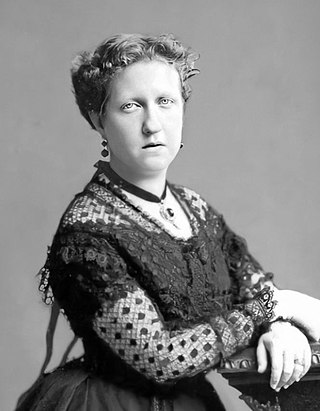
DonaIsabel, nicknamed "the Redemptress", was the Princess Imperial of the Empire of Brazil and the Empire's regent on three occasions. Born in Rio de Janeiro as the eldest daughter of Emperor Pedro II of Brazil and Empress Teresa Cristina, she was a member of the Brazilian branch of the House of Braganza. After the deaths of her two brothers in infancy, she was recognized as her father's heir presumptive. She married a French prince, Gaston, Count of Eu, in an arranged marriage and they had three sons.
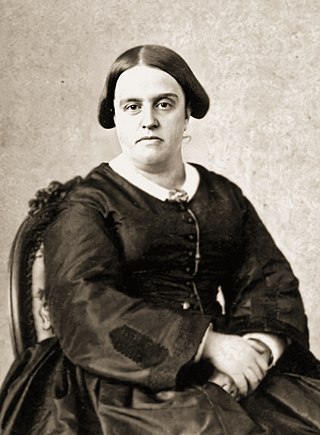
Princess Januária of Brazil was a Brazilian princess and Portuguese infanta (princess). She was the second daughter of Pedro I of Brazil and IV of Portugal and his first wife, Archduchess Maria Leopoldina of Austria.
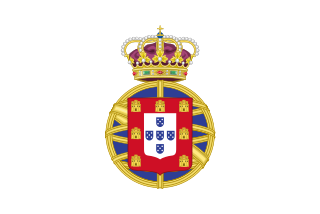
The United Kingdom of Portugal, Brazil and the Algarves was a pluricontinental monarchy formed by the elevation of the Portuguese colony named State of Brazil to the status of a kingdom and by the simultaneous union of that Kingdom of Brazil with the Kingdom of Portugal and the Kingdom of the Algarves, constituting a single state consisting of three kingdoms.
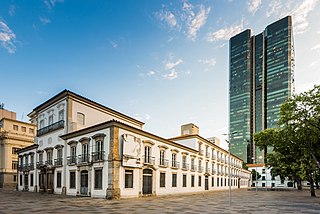
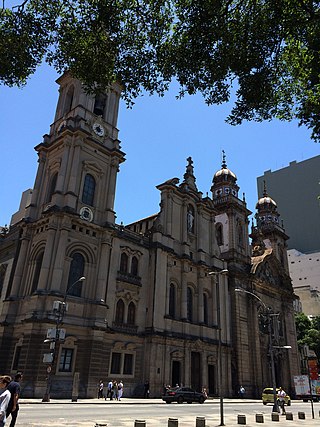
The Old Cathedral of Rio de Janeiro dedicated to Our Lady of Mount Carmel is an old Carmelite church which served as cathedral (Sé) of Rio de Janeiro from around 1808 until 1976. During the 19th century, it was also used successively as Royal and Imperial Chapel by the Portuguese Royal Family and the Brazilian Imperial Family, respectively. It is located in the Praça XV square, in downtown Rio. It is one of the most important historical buildings in the city.

Paço de São Cristóvão was an imperial palace located in the Quinta da Boa Vista park in the Imperial Neighbourhood of São Cristóvão, Rio de Janeiro, Brazil. It served as residence to the Portuguese royal family and later to the Brazilian imperial family until 1889, when the country became a republic through a coup d'état deposing Emperor Pedro II. The palace briefly served as a public building by the provisional government for the constituent assembly of the first republican constitution. It housed the major part (92.5%) of the collections of the National Museum of Brazil, which, together with the building, were largely destroyed by a fire on 2 September 2018.

The early life of Pedro II of Brazil covers the period from his birth on 2 December 1825 until 18 July 1841, when he was crowned and consecrated. Born in Rio de Janeiro, the Brazilian Emperor Dom Pedro II was the youngest and only surviving male child of Dom Pedro I, first emperor of Brazil, and his wife Dona Leopoldina, archduchess of Austria. From birth, he was heir to his father's throne and was styled Prince Imperial. As member of the Brazilian Royalty, he held the honorific title "Dom".

The decline and fall of Pedro II of Brazil took place in the 1880s. It coincided with a period of economic and social stability and progress for the Empire of Brazil, with the nation achieving a prominent place as an emerging power in the international arena.

Dom Pedro Afonso was the Prince Imperial and heir apparent to the throne of the Empire of Brazil. Born at the Palace of São Cristóvão in Rio de Janeiro, he was the second son and youngest child of Emperor Dom Pedro II and Dona Teresa Cristina of the Two Sicilies, and thus a member of the Brazilian branch of the House of Braganza. Pedro Afonso was seen as vital to the future viability of the monarchy, which had been put in jeopardy by the death of his older brother Dom Afonso almost three years earlier.
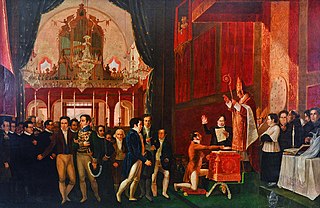
The regency period is how the decade from 1831 to 1840 became known in the history of the Empire of Brazil, between the abdication of Emperor Pedro I, on 7 April 1831, and the declaration of age of Pedro II, who was legally declared of age by the Senate at the age of 14 on 23 July 1840.
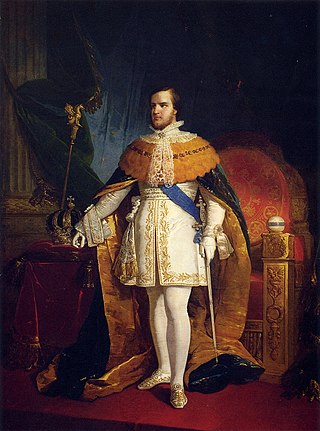
The Second Reign is a period of history within the Empire of Brazil that lasted 49 years, beginning with the end of the regency period on 23 July 1840, upon the declaration of Pedro de Alcântara's majority, and ending on 15 November 1889, when the parliamentary constitutional monarchy in force was removed by the proclamation of the republic.

The Declaration of age of Pedro II, also referred to as the Majority Coup in Brazilian history, happened on July 23, 1840, with the support of the Liberal Party and put an end to the Brazilian Regency period. The liberals mobilized the people, who pressured the Senate to declare Pedro II of legal age before he turned 15. In 1834, the Portuguese Parliament had already declared the age of majority for Maria II, Pedro II's sister, who became queen without a regent.